Sunshine and Greenspace, by Marc Sorenson, EdD.
A part of my life, albeit I did not fully savor nor appreciate them.
Sunshine and greenspace should  be loved by all. Greenspace is an area of grass, trees, or other vegetation set apart for recreational or aesthetic purposes. In my case, there was not much winter participation outdoors and there was not much green. There was school study inside, snow and ice outside and not much greenery. Thus, thus colds and other irritating illnesses ruled my life. In summers, I spent my life on our ranch, working hay fields, chasing cattle bare-chested and doing other sundry chores. In addition, “green” was all around me in summer, since green fields of alfalfa corn and grass were ubiquitous. Consequently, my health was perfect! Of course, because of the Sunshine that blazed much of the day, there were other benefits. I was the recipient of nitric oxide, dopamine, circadian-rhythm entrainment, serotonin, endorphin, BDNF and vitamin D. King Kong could not have felt much better than I felt.
be loved by all. Greenspace is an area of grass, trees, or other vegetation set apart for recreational or aesthetic purposes. In my case, there was not much winter participation outdoors and there was not much green. There was school study inside, snow and ice outside and not much greenery. Thus, thus colds and other irritating illnesses ruled my life. In summers, I spent my life on our ranch, working hay fields, chasing cattle bare-chested and doing other sundry chores. In addition, “green” was all around me in summer, since green fields of alfalfa corn and grass were ubiquitous. Consequently, my health was perfect! Of course, because of the Sunshine that blazed much of the day, there were other benefits. I was the recipient of nitric oxide, dopamine, circadian-rhythm entrainment, serotonin, endorphin, BDNF and vitamin D. King Kong could not have felt much better than I felt.
It is apodictic that my good feelings and perfect physical rhythms were due to sunshine and greenspace. Yet, I believe I could have chosen to be outside more in the winter.
My parents raised me on the Utah/Nevada border. Hence, there was plenty of snow, but also plenty of sun in the winter. The nearby mountains and evergreen forests furnished a lot of green year-round. UVA light, lacking in the capacity to produce vitamin D, produces nitric oxide, serotonin and helps to reset the circadian rhythms. It might have enhanced my dark mood in winter. Nevertheless, due to my distaste of cold weather, I stayed inside to study and spent time in the gym.
It was not until much later that I learned the value of sunshine and greenspace.
Now it seems like there are a plethora of studies that praise the value of greenspace. I added the word “sunshine” in this paper because of my belief that majority of the benefits occur due to sunlight. The most eye opening and impressive of those studies is one called, The Health Benefits of the Great Outdoors. A Systematic Review and Meta-Analysis of Greenspace Exposure and Health Outcomes. It was a meta-analysis (highly respected and statistically believable). In addition, it used data from 103 observational and 40 interventional studies. It also measured 100 different health outcomes for people who participated (or did not) in greenspace areas and activities.
The remarkable results and health benefits of the great outdoors.
Here are the highly impressive and significant results of increased greenspace exposure.
Greenspaces associated with reduced risk of the following measurements:
- Salivary cortisol (the body’s main stress hormone).
- heart rate (-2.7 bpm)
- diastolic blood pressure (-1.97)
- HDL cholesterol (-.003)
- Low-frequency heart rate variability (-.06)
- pre-term birth (-13)
- type II diabetes (-.28)
- All-cause mortality (-.31)
- Small size for gestational age (-.19)
- Cardiovascular mortality (-.16)
In addition, there was an increased incidence of good self-reported health.
The researchers also reported, “The incidence of stroke, hypertension, dyslipidaemia, asthma, and coronary heart disease were reduced.” “For several non-pooled health outcomes, between 66.7% and 100% of studies showed health-denoting associations with increased greenspace exposure including neurological and cancer-related outcomes, and respiratory mortality.”
Save the Children!
In conclusion, one recent study on children shows that mental health problems, addiction, and neurotic or stress related disorders reduced between 40-50%. This same study showed that greenspace appeared to lower the risk of personality disorders, bipolar and mood disorders, and schizophrenia.
The message of course, is to get outdoors where it is green. Then, sunshine and greenspace can work together for wonderful health benefits.
For the research on the magnificent health affects of regular, non-burning sun exposure, visit sunlightinstitute.org and read the book Embrace the Sun, by Sorenson and Grant.
Coronavirus, sunlight and vitamin D. More compelling information. Take action now. By Marc Sorenson, EdD.

 Coronavirus, (Covid-19), like most flu-like diseases, will probably disappear in much of the Northern hemisphere in the coming summer. Nevertheless, it will return on steroids in the fall and winter. Yet, it does not have to return to you or your family and friends. We can do something! However, why wait? Let us start now! Does anyone reading this really want to wait for the “second wave” and then go into panic mode? Of course not. In addition, do you want to let the vaccine Nazis also spend $billions more of our tax dollars looking for a vaccine? Of course not. The answer to stopping coronavirus is all around us. We need only to seek it and use it.
Coronavirus, (Covid-19), like most flu-like diseases, will probably disappear in much of the Northern hemisphere in the coming summer. Nevertheless, it will return on steroids in the fall and winter. Yet, it does not have to return to you or your family and friends. We can do something! However, why wait? Let us start now! Does anyone reading this really want to wait for the “second wave” and then go into panic mode? Of course not. In addition, do you want to let the vaccine Nazis also spend $billions more of our tax dollars looking for a vaccine? Of course not. The answer to stopping coronavirus is all around us. We need only to seek it and use it.
Two papers show remarkable associations of coronavirus with vitamin D.
If you are not convinced of the power of sunlight after reading this, I despair of being able to help you prevent this fall’s “second wave.”
The first paper was by a team of Indonesian researchers. One might think that Indonesians would have ample vitamin D levels due to an abundance of sunlight. Thus, this should protect them from vitamin D deficiency. However, most Indonesians avoid the sun and keep their skins as white as possible. It is a national quest in the Philippines to be as light-skinned as possible, so that they can consider themselves as “upper crust.” Hence, the population has a great deal of vitamin D deficiency.
The researchers focused on identifying patterns of mortality (death) between coronavirus deaths and vitamin D levels. They conducted the study with a sample of 780 subjects, all who had laboratory confirmed coronavirus infection.
Here are the findings on vitamin D levels and coronavirus mortality:
- Mortality rates were 13 times higher in patients who were vitamin D insufficient (21-29 ng/ml) compared to those who had normal levels (>30 ng/ml).
- Mortality rates were 19-times higher in patients who were vitamin D deficient (<20 ng/ml).
- Even when controlling the data for age, gender and preexisting conditions, the vitamin D deficient cases were more than 10 times more likely to die than those who had normal levels.
No wonder the Indonesians are now seeking the sun and appreciating it after years of avoiding it. See the picture below of Indonesian men social distancing while soaking up the rays.
An important point regarding vitamin D and coronavirus:
Vitamin D levels above 30 ng/ml are not necessarily “normal,” and it is likely that 50-60 ng/ml would be a better number. People who are constantly in the sunshine, i.e. lifeguards, often have levels above 70 ng/ml. Dr. Bruce Hollis and his colleagues suggested that lifeguards have the “true normal” levels. They believe that a population of “normal” volunteers with average levels of 27 ng/ml may exhibit vitamin D deficiency. Another similar study showed that “normal” adults had 25(OH)D levels of about 27.2 ng/ml, whereas lifeguards had levels of approximately 70 ng/ml].
Could the real pandemic be a pandemic of sunlight deficiency resulting in a pandemic of vitamin D deficiency?
If >30 ng/ml provides this much protection against coronavirus, levels > 60 ng/ml would probably provide complete protection. Everyone should have a vitamin D assessment, and then get out in the sun, during this time of the coronavirus epidemic. For your own health, and the health of those you love, schedule a test, and make your goal 60 ng/ml.
Paper # 2
Another paper by Mark Alipio, done in the Philippines, was similar to the Indonesian study. Thus, it showed that coronavirus patients with normal vitamin D levels had a mild disease outcome. The outcome for those patients was 19.6 times better than for those with low levels.
A fact everyone should remember:
Ninety percent of serum vitamin D levels are due to sun exposure, which causes the skin to produce vitamin D3. Therefore, vitamin D levels are surrogate measurements for sun exposure. You must not assume that vitamin D capsules will supply all the beneficial effects of sun exposure or sunbed exposure. Both sunlight and sunbed light produce photoproducts that have health effects far beyond vitamin D. Safely sunbathe (without burning) to achieve optimal vitamin D levels. Moreover, while so doing, you will produce other remarkably important health benefits.
For more information on the extraordinary health benefits of sun exposure, visit sunlightinstitute.org and read my book, Embrace the Sun.
Sunshine and gut inflammation by Marc Sorenson, EdD
Sunshine dampens chronic gut inflammation: Crohn’s and ulcerative colitis.
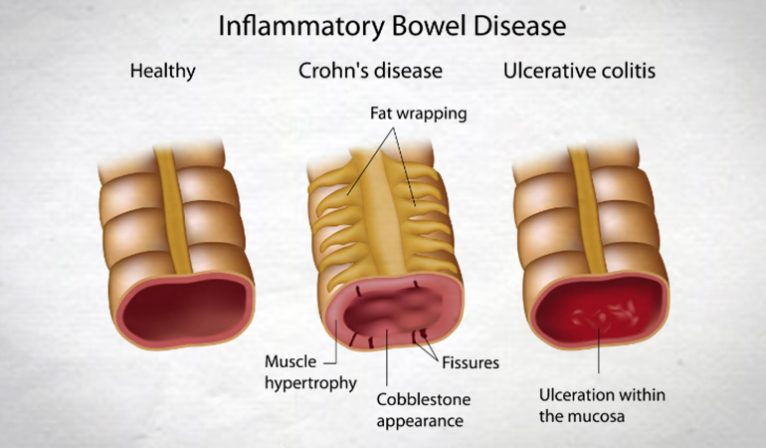
Sunshine helps to reduce chronic gut inflammation, which is usually due to two diseases: Crohn’s disease (CD) and ulcerative colitis. These two diseases are known as inflammatory bowel diseases (IBD), and worldwide, there are 800,000 people who live with those two life-long disorders. And, these diseases are autoimmune diseases, where the body attacks itself.
In addition, these diseases are hard to live with because they cause diarrhea, abdominal pain, inflammation and general misery. Each year more children contract IBD and each year, they contract it at younger ages. Most noteworthy, in my opinion, is the fact that IBD is, to a great extent, a sunshine deprivation disease. Children’s sunshine deprivation is horrific because it is child abuse, due to erroneous messages of dermatologists, AKA the Powers of Darkness.
Especially relevant is the fact that sunshine may profoundly decrease IBD. And, new research shows that the anti-inflammatory effects of sunshine are remarkably helpful.[1]
And here are the salient messages of this new sunshine research:
- First of all, children who were outside and exposed to sunshine for an extra half hour a day were protected. Thus, they had a 20% lower risk of developing IBD.
- Another finding was reported by Dr. Robyn Lucas, the lead researcher. Each 10 minutes of sun exposure was associated with a six% lower risk of developing IBD, [so do you want to deprive your children of sun exposure?]
- She also stated: “At this stage what we have shown is there is a link between lack of sun exposure and increased risk of IBD…”
- Furthermore, Dr. Lucas made this observation: “Taking children to play outside in the sun could be life-changing.”
Also, I should add that what is true for these children is also true for adults. Read more in the new book, Embrace the Sun, by Marc Sorenson and William Grant. https://www.amazon.com/Embrace-Sun-Marc-B-Sorenson/dp/069207600X
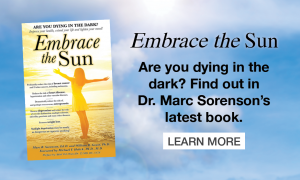
Find more information on http://sunlightinstitute.org/, particularly at this link: http://sunlightinstitute.org/low-levels-of-sunlight-exposure-predispose-to-inflammatory-bowel-disease-and-fractures/
So be sure to obtain regular, non-burning sunshine, whether for yourselves or your children. Happy sunning!
[1] Holmes EA, Ponsonby AL, Pezic A, Ellis JA, Kirkwood CD, Lucas RM. Higher Sun Exposure is Associated with Lower Risk of Pediatric Inflammatory Bowel Disease: A Matched Case-Control Study. Journal of Pediatric Gastroenterology and Nutrition, 2019; May 15 (Epub ahead of print).
 An innate need for sunlight exists within the human body and soul.
An innate need for sunlight exists within the human body and soul.
First of all, consider the opening line of a recent article in the New York Times: “Let there be light. Please.” And, the article states that people in New York City (NYC) love to seek apartments with sunlight. It is also especially relevant that such apartments demand premium prices. But sun seekers have a problem because of the continuous building of new high rises. Consequently, they must look at the city’s future building plans before they fulfill their innate need for sunlight. This is because new buildings may be built that block whatever sunlight is available.
Problems encountered in fulfilling the innate need for sunlight in NYC.
Therefore, it is a difficult situation to satisfy the innate need for sunlight in NYC. And no wonder people in the southern states have lower cancer rates, despite their atrocious eating habits.[1] Why? Because they have one of the best cancer fighters: sunlight.
An example of the rather impressive anti-cancer power of sunlight: Iranian research demonstrated the innate need for sunlight. Women who avoided sun exposure had 10 times the breast cancer risk.[2] That is, of course, when they were compared to women who were able to obtain regular sunlight. This is because the innate need for sunlight was being ignored among women forced to avoid sun.
What other diseases are manifest when we ignore our innate need for sunlight?
Lack of sun exposure increases the risk of 16 other cancers, heart disease, vitamin D deficiency, multiple sclerosis, hip fractures, depression and myriad others. (See my book, Embrace the Sun, for a full discussion.) The innate need for sunlight manifests itself in higher rates of these “killer” diseases worldwide.
According to the NYT article, “there are those who view light as an elemental need, one that trumps everything else, including location, closets, level floors, an elevator, a doorman and proximity to Trader Joe’s.” Obviously, the people recognize, at a visceral level, their innate need for sunlight.
Do the Chinese have an innate need for sunlight?
Another article also emphasized the innate need for sunlight.[3] And, this one came from halfway around the world, in Shanghai. It seems like the Chinese should know about sun healing, since their experience in healing goes back thousands of years. Hence, they would not need to read this article to appreciate the innate need for sunlight. A real-estate developer there had to pay a family the equivalent of $15,650.00 for robbing them of their sun. One of the developer’s skyscrapers exceeded the legal height, and partially blocked the sun to their apartment. Consequently, this prevented the family from obtaining their government-mandated sun allotment. The allotment was two hours per day, and the skyscraper allowed only 1-2 hours of sun.
A judge who understands the innate need for sunlight
The judge in the case said, “We can’t live without sunshine” and told the developers they had to respect the rights of the people to enjoy the sun. Due to this judge’s understanding of the innate need for sunlight, justice was done.
Why is the innate need for sunlight not recognized in the U.S? Good question!
The Chinese experience is in stark contrast with the US. First of all, in the 1990s, a president of the American Academy of Dermatology (AAD) made this statement. “In some vision as I grow older I see us moving to more shelters and perhaps underground living because of these hazards” (meaning sun exposure).[4] Also, she stated that melanoma would cause more cancer deaths than any other cancer by about 2010. Since it is now 2018, and we are not yet living underground, she was ridiculously wrong. In addition, melanoma is nowhere near the top of the cancer-deaths charts. It kills far less people than most major cancers like lung, breast, colon and prostate. However, it will probably increase in incidence as more people are convinced by the ADD to avoid their innate need for sunlight.
When it comes to the innate need for sunlight, the Chinese have more smarts!
It appears that the Chinese are a whole lot smarter than the AAD regarding the innate need for sunlight! Therefore, the AAD’s insistence on sun avoidance is likely to destroy public health. And, soaking up some safe, unobstructed, regular sunlight will enhance health. The AAD’s insistence on sun avoidance is much more likely to destroy the health of the American public than soaking up some unobstructed sunshine. So please, PLEASE enjoy some safe, non-burning sun, winter and summer, while you improve your health! And remember that sunscreens inhibit 95% of vitamin D production. Therefore, when you have had enough sun exposure, cover up with clothing or seek shade. Those who use sunscreens have far more sunburns than those who do not use it.[5] Think about it, and read my book, Embrace the Sun so that you can be comfortable while attending to your innate need for sunlight. https://www.amazon.com/Embrace-Sun-Marc-B-Sorenson/dp/069207600X 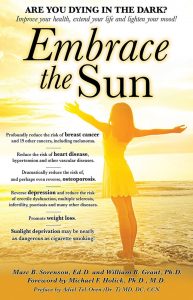
[1] Sorenson, M. Vitamin D3 and Solar Power. Chapter 8. 2008.
[2] Bidgoli SA, Azarshab H. Role of vitamin D deficiency and lack of sun exposure in the incidence of premenopausal breast cancer: a case control study in Sabzevar, Iran. Asian Pac J Cancer Prev. 2014;15(8):3391-6.
[3] http://www.shanghaidaily.com/national/Sun-suit-Family-wins-payout/shdaily.shtml
[4] Dr. Wilma Bergfeld, then-president of the American Academy of Dermatology at Derm Update, the AAD’s 1996 annual media day, Nov. 13, 1996.
[5] Silva ESD, Tavares R, Paulitsch FDS, Zhang L. Use of sunscreen and risk of melanoma and non-melanoma skin cancer: a systematic review and meta-analysis. Eur J Dermatol. 2018 Apr 1;28(2):186-201.
Multiple sclerosis is a sunlight-deficiency disease. Another reason to embrace the sun. By Marc Sorenson, EdD
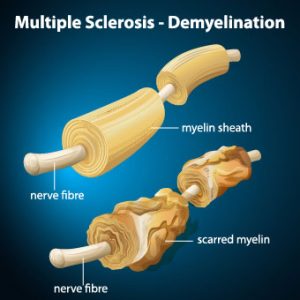 First of all, multiple sclerosis is a terrible autoimmune disease in which immune cells attack myelin, the protective nerve cover.[1], [2] Hence, this process, known as demyelination, leaves the nerves bare and susceptible to “short circuiting.” This results in a debilitating disease which is often characterized by severe neural and muscular impairments. It may also result in sensory losses, bladder dysfunction, pain and visual problems due to nerve damage.
First of all, multiple sclerosis is a terrible autoimmune disease in which immune cells attack myelin, the protective nerve cover.[1], [2] Hence, this process, known as demyelination, leaves the nerves bare and susceptible to “short circuiting.” This results in a debilitating disease which is often characterized by severe neural and muscular impairments. It may also result in sensory losses, bladder dysfunction, pain and visual problems due to nerve damage.
MS is a big problem!
And recent findings, from National MS Society, estimate 1 million people in the United States have multiple sclerosis. Furthermore, this is more double the last reported number, and the first national research on multiple sclerosis prevalence since 1975. Consequently, it is estimated that about 200 new cases are diagnosed each week in the United States.[3]
Multiple sclerosis and sun exposure: What does new research say?
While no one disputes the horror of an increasing MS rate, a new study reiterates the vital need for sun exposure to prevent MS. Also, we are not surprised about the latest research. Why? Because the new study is simply a reiteration of myriad research papers and opinions showing that more sunlight reduces the risk.
In this research, 151 MS patients defined their previous lifetime sun exposure in the different seasons by questionnaire. In addition, they were compared to 235 non-patients who answered identical questionnaires.[1] As a result, those living in high-UVB areas experienced a 45% lower risk of multiple sclerosis. Living in those areas at ages 5 to 15 years also was associated with a reduced risk of 51-52%. UVB, of course, is a spectrum of light that emanates from the sun and causes tanning. In addition, it is used in sunbeds and sun lamps.
The conclusion regarding MS and sunlight.
In conclusion to their research, the authors stated, “Living in high ambient UVB areas during childhood and the years leading up to MS onset was associated with a lower MS risk. High summer sun exposure in high ambient UVB areas was also associated with a reduced risk.”
While this research is impressive, there is a plethora of additional science. Most noteworthy are the studies that follow. And, all show the association of sun exposure to lowered risk of MS.
Multiple sclerosis and the Davenport study
Probably, the most important early study was from 1922 by Dr. Charles Davenport. He wrote a paper entitled, “Multiple Sclerosis from the standpoint of geographic distribution and race.”[2] He analyzed the multiple sclerosis rates of military draftees and compared it to their states of origin. As a result, he showed that the highest rates were found in men who grew up in Michigan, Wisconsin, and the extreme northwest. These areas, of course, have very low sun availability. There were only a few cases of MS among those who grew up in southern states, where sun availability is abundant. In addition, Dr. Davenport also noted that draftees from urban areas, and where sun availability is low, had 50% higher MS rates than those who came from rural areas. Similar studies confirm that relationship. [3],[4] In 1979, assessments of the MS rates of USA military personnel Produced nearly identical results.[5]
Reducing relapse of multiple sclerosis through sunlight and/or vitamin D.
Mowry and colleagues, in correlating serum vitamin D to the rate of disease relapse, have reported the following: For every increase in serum levels of 10 ng/ml [25 nmol/L], there is a 34% decrease in the risk of relapse in young people.[6] Especially relevant, however, is that 90% of serum levels is derived from sun exposure. And, we also know that sun exposure has protective effects on MS beyond vitamin D.[7] Also, in the aforementioned research on vitamin D, high levels may really be surrogate measures for sun exposure. Sunlight and vitamin D are not the same.
More hours of sun equal lower risk of multiple sclerosis.
Most noteworthy, among people living in geographical locations, where there are 3,000 hours of available sun yearly, multiple sclerosis rates are quite low. [8] The same relationship exists when latitudes are correlated with rates of MS: And, The risk of MS in far northern areas is more than 100 times greater than it is in equatorial areas, where sunlight is intense, and the rate of MS approaches zero.[9], [10]
Therefore, for all who would like to prevent MS or reduce its exacerbation, soak up some regular, non-burning, safe sunlight. In conclusion, this is another of the wonderful benefits of our magnificent sun. It seems like a good time to indulge before the winter comes.
Finally, for more information on multiple sclerosis, read my new book, Embrace the Sun, available at Amazon.
References and footnotes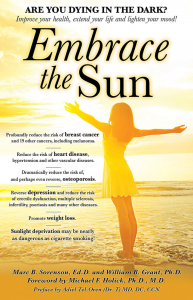
[1] Helen Tremlett, PhD, Feng Zhu, MSc, Alberto Ascherio, MD, DrPH, and Kassandra L. Munger, ScD.
[2] Davenport, C. Multiple Sclerosis from the standpoint of geographic distribution and race. Arch Neurol Psychiatry 1922;8:
[3] Acheson ED, Bachrach CA, Wright FM. Some comments on the relationship of the distribution of multiple sclerosis to altitude, solar radiation and other variables. Acta Psychiat (Scand) 1960;35 (suppl 147):132-47.51-58
[4] Norman JE Jr, Kurtzke JF, Beebe GW. Epidemiology of multiple sclerosis in USA veterans: 2. Latitude, climate, and risk of multiple sclerosis. J Chron Dis 1983;36:551-59
[5] Kurtzke JF, Beebe GW, Norman JE Jr. Epidemiology of multiple sclerosis in USA veterans: 1. Race, sex, and geographic distribution. Neurology 1979;29:1228-35.
[6] Mowry EM, Krupp LB, Milazzo M, Chabas D, Strober JB, Belman AL, McDonald JC, Oksenberg JR, Bacchetti P, Waubant E. Vitamin D status is associated with relapse rate in pediatric-onset MS. Annals of Neurology 2010;10.1002.
[7] Pantazou V, Schluep M, Du Pasquier R. Environmental factors in multiple sclerosis. Presse Med. 2015 ;44(4 Pt 2):e113-20.
[8] Goldberg, P. Multiple sclerosis: vitamin D and calcium as environmental determinants of prevalence (a viewpoint). Part I: sun, dietary factors and epidemiology. Int J Environ Studies 1974;6:19–27.
[9] Alter M, Yamoor M, Harshe M. Multiple sclerosis and nutrition. Arch Neurol l974;31:267-72.
[10] Kurtkze, J. Geography in multiple sclerosis. J Neurol 1977;215:1-26.
[1] Racke, M. Immunopathogenesis of multiple sclerosis. Ann Indian Acad Neurol. 2009 Oct–Dec; 12(4): 215–220.
[2] Markovic-Plese S, McFarland HF. Immunopathogenesis of the multiple sclerosis lesion. Curr Neurol Neurosci Rep 2001;1:257-62
[3] https://www.healthline.com/health/multiple-sclerosis/facts-statistics-infographic#2
 First of all, to think is to prevent poor test scores, win at business and otherwise be successful. And, if I think and remember clearly, I also prevent mental disabilities such as Alzheimer’s. Consequently, there are innumerable pills on the market that purportedly increase the ability to think. But you may need only one pill to improve your cognitive ability: the sunshine pill. It is most noteworthy that I’m not talking about vitamin D. Therefore, the sunshine pill is not really a pill at all. Rather, it is exposure to the UV light of sunlight itself, which helps prevent myriad diseases. Maybe we should call it the “magnificent non-pill.”
First of all, to think is to prevent poor test scores, win at business and otherwise be successful. And, if I think and remember clearly, I also prevent mental disabilities such as Alzheimer’s. Consequently, there are innumerable pills on the market that purportedly increase the ability to think. But you may need only one pill to improve your cognitive ability: the sunshine pill. It is most noteworthy that I’m not talking about vitamin D. Therefore, the sunshine pill is not really a pill at all. Rather, it is exposure to the UV light of sunlight itself, which helps prevent myriad diseases. Maybe we should call it the “magnificent non-pill.”
How does the sunshine pill help us to think?
Recent research shows that exposure to sunlight causes a cascade of chemical reactions that help us to think.[1] Especially relevant is the fact that exposure to UV elevates a natural chemical known as blood urocanic acid (UCA). This chemical then crosses the blood-brain barrier. This chemical is then converted by a metabolic process to glutamate, and consequently, nerve synapses in the brain are enhanced. As a result, there were improvements in both physical learning (motor learning) and object recognition memory, which is an ability to think.
Is there more research indicating that sun exposure enhances the ability to think?
In addition, the ability to think has been shown in many research studies to improve with sunlight. Most noteworthy is a 2013 article, published in the journal Neurology.[2] It reveals that among people with high sun exposure, the risk of Alzheimer’s disease (AD) is profoundly decreased. Therefore, they are able to think more clearly than those who receive low sun exposure.
Finally, research published in the journal Endocrinology, sums up the effects of the sun on the brain and body: It is entitled, “How ultraviolet light touches the brain and endocrine system through skin, and why.”[3] The authors begin their abstract by stating that “the skin is a self-regulating protective barrier organ that is empowered with sensory and computing capabilities to counteract the environmental stressors to maintain/restore disrupted cutaneous homeostasis.” In other words, the skin has the ability to take on what life deals it, and maintain its equilibrium and balance. In addition, the skin communicates bidirectionally with the central nervous, endocrine and immune systems. Thus, it helps to maintain balance for all body systems, including the ability to think.
Safely soak up the non-burning sunlight and enhance your intelligence!
[1] Zhu et al., 2018, Cell 173, 1–12, June 14, 2018
[2] White RS, Lipton RB, Hall CB, Steinerman JR. Nonmelanoma skin cancer is associated with reduced Alzheimer disease risk. Neurology. 2013 21;80(21):1966-72.
[3] Slominski AT, Zmijewski MA, Plonka PM, Szaflarski JP, Paus R. How ultraviolet light touches the brain and endocrine system through skin, and why. Endocrinology. 2018 Mar 12. [Epub ahead of print]
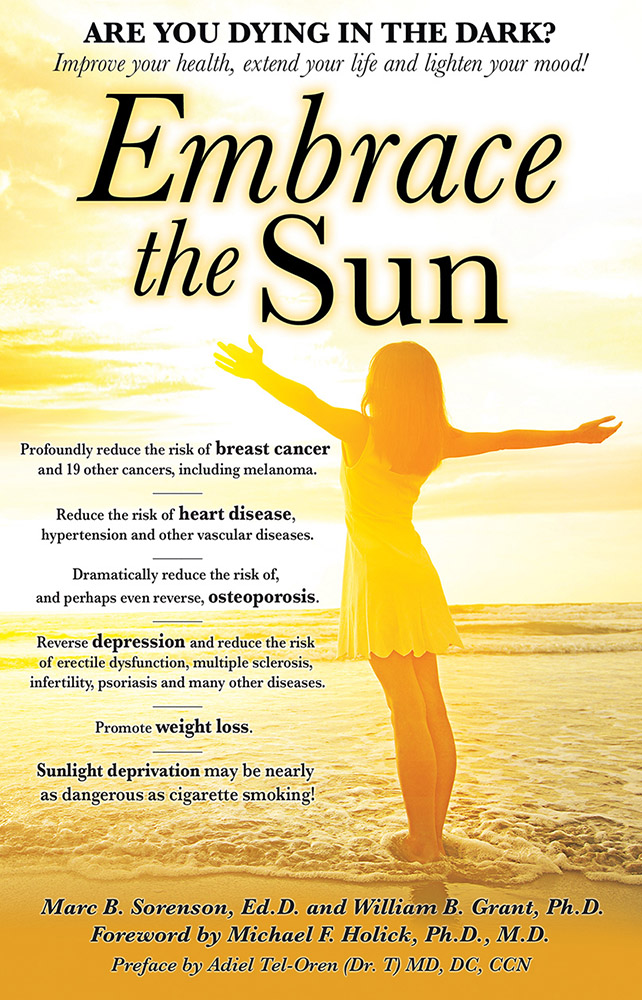 New book, Embrace the Sun, recommends non-burning sun exposure, citing research on sun exposure, vitamin D, and disease risk.
New book, Embrace the Sun, recommends non-burning sun exposure, citing research on sun exposure, vitamin D, and disease risk.
Available on Amazon, Embrace the Sun, by authors Marc B. Sorenson, Ed.D. and William B. Grant, Ph.D., claim that sun avoidance may be nearly as hazardous to your health as cigarette smoking! Will there soon be a Surgeon General’s warning about staying indoors or putting on too much sunscreen? Is this book based on science or pure science fiction?
The book is based on science and research. Together, Sorenson and Grant have worked 62 years studying and practicing health, nutrition, and the proper relationship with sunlight. A mountain of evidence exists showing that sunlight can promote weight loss, reduce depression, and profoundly decrease the risk of today’s common diseases including most cancers, heart disease, autism, diabetes, osteoporosis, multiple sclerosis, infertility, preterm birth and psoriasis. Do I have your attention? This book provides solid evidence towards a case for regular, sensible sun.
“Marc Sorenson and Bill Grant take us on a delightful journey to better understand the health benefits of our magnificent sun at a time when our sun has been demonized by various health organizations, including the dermatology community, which has been essentially unchallenged for the past 50 years,” said Michael F. Holick, Ph.D., M.D., Boston University Medical Center, “Embrace the Sunis an easy read that is chock-full of valuable information about the health benefits of sensible sun exposure. It provides a very practical guide on how to take advantage of our Magnificent Sun.”
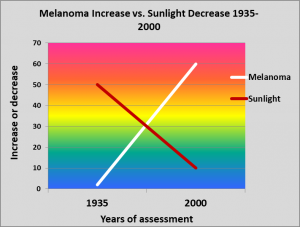 According to the book, 75% of all melanomas occur on areas of the body that are seldom or never exposed to sunlight. Additionally, sun exposure has decreasedby about 90% in the U.S. population since 1935. During that same period, melanoma incidence has increasedexponentially, by approximately 3,000%! This evidence debunks the myth that melanoma is caused primarily by the sun, and instead suggests that the disease is at least partially caused by sun deprivation.
According to the book, 75% of all melanomas occur on areas of the body that are seldom or never exposed to sunlight. Additionally, sun exposure has decreasedby about 90% in the U.S. population since 1935. During that same period, melanoma incidence has increasedexponentially, by approximately 3,000%! This evidence debunks the myth that melanoma is caused primarily by the sun, and instead suggests that the disease is at least partially caused by sun deprivation.
“This book is a tour de force for health effects of exposure to the sun,” said Cedric F. Garland, Dr. Ph. F.A.C.E., University of California at San Diego. “It is written simply enough and in such a light-hearted vein that any intelligent fifth grader can and should read it. It also should be required reading for every upcoming doctor in training and all health care professionals.”
Sorenson and Grant prepare the reader to make an informed choice. With summer coming, is it wise to get out regularly at midday, exercise, and soak up some rays? Or better to stay indoors, continuing the current regimen? Could it be that something so central to nature, the sun, which has been part of the human race for thousands of years is now bad for us? In this blip that is the late 20thand beginning 21stcentury has sun avoidance been helpful or hurtful? Read Embrace the Sun and find out!
About Marc B. Sorenson, Ed. D.
Dr. Sorenson is a doctor of education (EdD) with a health background. He and his wife, Vicki, developed one of the world’s top resorts (National Institute of Fitness). During 20 years, their clients lost over 100 tons of fat; two thirds of diabetic guests were freed of medication in two weeks; and others recovered from cholesterol, arthritis, and myriad additional maladies. Sorenson has written ten books and hundreds of blogs for his site, Sunlight Institute. On the recommendation of Senator Orrin Hatch, a flag was flown over the U.S. Senate building to honor his contributions to world health.
About William B. Grant, Ph.D.
Dr. William Grant is an epidemiologist and founder of the nonprofit organization Sunlight, Nutrition and Health Research Center. Grant holds a PhD in Physics from UC Berkeley and worked as a senior research scientist in the field of optical and atmospheric sciences at SRI International, JPL, and NASA Langley.
He published the first paper linking dietary factors to risk of developing Alzheimer’s disease in 1997. Since 2000, he has focused on ultraviolet-B (UVB) radiation and vitamin D and their relation to cancer and other diseases. He has written over 256 peer-reviewed articles, editorials, and letters to the editor on vitamin D and health.
 Does cognitive loss lead to dementia? Yes. Is vitamin D important to the risk of cognitive loss? Yes. Do those levels also influence the ability to think (cognitive ability)? In 2002, 252 people were assessed for vitamin D levels, signs of dementia and cognitive ability.[1] And, in 2012 another assessment was completed. The data was then assessed to determine if the initial vitamin D levels were associated with different risks of dementia and cognitive ability after 10 years.
Does cognitive loss lead to dementia? Yes. Is vitamin D important to the risk of cognitive loss? Yes. Do those levels also influence the ability to think (cognitive ability)? In 2002, 252 people were assessed for vitamin D levels, signs of dementia and cognitive ability.[1] And, in 2012 another assessment was completed. The data was then assessed to determine if the initial vitamin D levels were associated with different risks of dementia and cognitive ability after 10 years.
Cognitive ability results:
First of all, those with higher vitamin D levels at the beginning of the ten-year period had about 40% better executive functioning at the end of the period compared with those who had lower vitamin D levels (executive functions are a set of processes that all have to do with managing oneself and one’s resources in order to achieve a goal, and they can be viewed as the “conductor” of all cognitive skills.)[2]
Of course, vitamin D levels are determined by the quantity of sun exposure one receives. Therefore, we could say that vitamin D levels are a surrogate measurement of sun exposure.
Other research on sunlight and cognitive ability:Much research has been done on the association of sun exposure on cognitive abilities, so this research is no surprise. Especially relevant are the results of more recent research, based on a 15-year residential history of varying degrees of sun exposure. It has also shown cognitive impairment in persons who were below the median exposure to sun was 88% greater than those who were above the median.[3] Researchers mentioned vitamin D as a possible mechanism by which sun positively influenced cognitive abilities. And, they also remarked that regulation of the circadian rhythm by sun could be a factor. Additionally, these same investigators had previously shown the following: lower levels of sun exposure resulted in a 2.6-times higher incidence of cognitive impairment.[4]
Does BDNF play a part in protecting cognitive ability?
Part of the reason for better cognitive skills under the influence of sun exposure may not have anything to do with vitamin D. It could be due to a chemical called Brain-derived neurotropic factor (BDNF). It is a part of a cascade of proteins promoting growth of neurons and preventing nerve death.[5] It is especially relevant that BDNF levels have been shown to increase significantly after bright light exposure.[6] And, in what I would consider to be a remarkably important study, both light exposure and treadmill exercise increased the expression of BDNF in rats.[7] And—as the researchers showed—exercise and/or bright light promoted neurogenesis (new nerve cell growth) in the adult rat brain. How important is this finding for adults who are worried about cognitive decline? Furthermore, we are actually seeing an example of new brain cells being built by bright light and exercise! Researchers have shown that BDNF has an effect on behavior, mood (e.g. depression), and brain adaptation (e.g. plasticity) and that its levels fluctuate seasonally in correlation with the amount of ambient sun:[8]
In addition, we can add one more natural chemical inversely associated with cognitive decline, depression, memory loss, and nervous system degeneration, and directly associated with sun exposure. We now have vitamin D, serotonin, endorphins, dopamine and BDNF. Hence, sun exposure is absolutely necessary to human health. Be sure you are obtaining your share! Don’t let your mind deteriorate due to avoiding the sunlight.
Embrace the sun, but do it safely. Finally: avoid sunburn.
[1] Alicia M. Goodwill, Stephen Campbell, Steven Simpson Jr, Maria Bisignano,
Cherie Chiang, Lorraine Dennerstein, Cassandra Szoekea. Vitamin D status is associated with executive function a decade later: Data from the Women’s Healthy Ageing Project. Maturitas 107 (2018) 56–62
[2] http://www.ldonline.org/article/29122
[3] Kent ST, Kabagambe EK, Wadley VG, Howard VJ, Crosson WL, Al-Hamdan MZ, Judd SE, Peace F, McClure LA. The relationship between long-term sun radiation and cognitive decline in the REGARDS cohort study. Int J Biometeorol. 2014 Apr;58(3):361-70.
[4] Kent ST, McClure LA, Crosson WL, Arnett DK, Wadley VG, Sathiakumar N. Effect of sun exposure on cognitive function among depressed and non-depressed participants: a REGARDS cross-sectional study. Environ Health. 2009 Jul 28;8:34
[5] http://scicurious.scientopia.org/2010/12/13/bdnf-and-depression/
[6] Tirassa P1, Iannitelli A, Sornelli F, Cirulli F, Mazza M, Calza A, Alleva E, Branchi I, Aloe L, Bersani G, Pacitti F. Daily serum and salivary BDNF levels correlate with morning-evening personality type in women and are affected by light therapy. Riv Psichiatr. 2012 Nov-Dec;47(6):527-34.
[7] Kwon SJ, Park J, Park SY, Song KS, Jung ST, Jung SB, Park IR, Choi WS, Kwon SO. Low-intensity treadmill exercise and/or bright light promote neurogenesis in adult rat brain. Neural Regen Res. 2013 Apr 5;8(10):922-9.
[8] Molendijk ML, Haffmans JP, Bus BA, Spinhoven P, Penninx BW, Prickaerts J, Oude Voshaar RC, Elzinga BM. Serum BDNF concentrations show strong seasonal variation and correlations with the amount of ambient sun. PLoS One. 2012;7(11):e48046.
 Blood pressure is determined by (1) the amount of blood the heart pumps and the amount of resistance to blood flow in the arteries. Consequently, the more blood the heart pumps, and the tighter the arteries, the higher the blood pressure.[1]
Blood pressure is determined by (1) the amount of blood the heart pumps and the amount of resistance to blood flow in the arteries. Consequently, the more blood the heart pumps, and the tighter the arteries, the higher the blood pressure.[1]
Chronic high blood pressure, or hypertension, can damage arterial walls and can eventually lead to an increased risk from heart disease, heart failure, other arterial diseases, kidney disease, irregular heart rhythms, osteoporosis, cognitive dysfunction, painful intercourse and stroke.[2] High blood pressure, also known as hypertension, is rampant in western societies. Untreated high blood pressure is a major killer. It is especially dangerous because it is primary risk factor for heart disease and stroke.
I have written several blogs on high blood pressure. Nevertheless, the experience of my friend Wayne may provide impetus for hypertension sufferers to try the sunshine solution.
Wayne, a resident of Texas, came to our former health resort seeking help for conditions of high blood pressure, obesity and various other maladies. I recommended, along with our healthful nutrition program, that he should sunbathe daily. Consequently, he “took it to heart” and could be found outside by the pool daily, dutifully soaking up the midday sunlight.
Wayne arrived at our program with a blood pressure of 157 systolic and 97 diastolic (157/97). Most noteworthy, those numbers put him at high risk for a stroke. Normal blood pressures are considered below 120 systolic, and below 80 diastolic. Four weeks later, as a result of his lifestyle changes. His numbers dropped to 125/54, meaning that he progressed from high stroke risk to very low stroke risk. Especially relevant is the fact that these changes were accomplished without medication.
The average drop in blood pressure among all guests at that program was 16 systolic and 12 diastolic. This is remarkable, considering that many of them had normal levels coming in.
Here are just a few of the blood pressure changes accomplished during that time:
- Frieda, from Oregon, lowered her blood pressure 33 points systolic and 30 points diastolic.
- Joyce, from Rhode Island, lowered her blood pressure 31 points systolic and 24 points diastolic.
- Jeff, from Utah, lowered his blood pressure 39 points systolic and 12 points diastolic.
- Susan, from New York, lowered her blood pressure 20 points systolic and 26 points diastolic.
Was all of this success due to sun exposure?
It should not be construed that these results were all a result of sun exposure. Nor should we conclude that hypertension is a result of sun deprivation. Typical American citizens engage daily in “killer” nutrition, subjecting themselves to dietary patterns and chemical additives that never existed in human life until modern times. Therein lie the major causes of hypertension. Hence, part of the improvements in blood pressure were due to the dietary changes we implemented with our guests.
More research regarding sunlight and blood pressure:
Sun exposure can, to an extent, act as an antidote to the poisons we consume. And, it acts much more quickly than dietary changes. Consider this: Dr. Oplander and his colleagues demonstrated that whole-body Ultraviolet A (UVA) irradiation worked what seemed like a miracle.[3] It caused a rapid, significant decrease of 11% in both systolic (upper number) and diastolic (lower number) blood pressure 30 minutes after the exposure. That change lasted up to 60 minutes. The lowered blood pressure lasted up to 60 minutes. Not only did blood pressure decrease, but arterial blood flow increased by 68%.
Nitric oxide, a potent vasodilator (blood-vessel relaxer) that occurs with sun exposure, was the photoproduct that led to these spectacular, important changes. This is important, because UVA is available almost any time the sun shines, winter and summer. Ultraviolet B (UVB) is not available in some areas during winter, due to the sun’s angle. This is especially true in the higher latitudes of the Northern hemisphere, or in the lower latitudes of the Southern hemisphere. UVB stimulates the production of vitamin D. So, it is especially relevant here that vitamin D was not involved in the lowering of blood pressure in Dr. Oplander’s study. Nitric oxide, however, was very involved.
Let’s take a look at one more study of sun exposure and hypertension: research China demonstrates that exposure to sun correlates to a lowered risk:[4] In a randomly selected population of Chinese residents from Macau (where the rate of hypertension is very high), the following risk factors for hypertension were assessed: lack of sun exposure, low intake of fish, smoking, obesity and lack of exercise. An average of more than one-half hour of sun exposure per day, as compared to no sun exposure, predicted a 40% reduced risk for hypertension.
I could go on for another page about the horrors of blood-pressure medication, but what I have said suffices. Non-burning sun exposure is one of the best elixirs for hypertension. In conclusion, one might say that it is no wonder that Wayne overcame his blood pressure problem!
[1] Mayo Clinic Diseases and Conditions: High blood pressure (hypertension). http://www.mayoclinic.org/diseases-conditions/high-blood-pressure/basics/definition/con-20019580 (accessed January 5, 2016).
[2] Ann Pietrangelo. Healthline 2014 http://www.healthline.com/health/high-blood-pressure-hypertension/effect-on-body (accessed January 4, 2016).
[3] Opländer C, Volkmar CM, Paunel-Görgülü A, van Faassen EE, Heiss C, Kelm M, Halmer D, Mürtz M, Pallua N, Suschek CV.. Whole body UVA irradiation lowers systemic blood pressure by release of nitric oxide from intracutaneous photolabile nitric oxide derivates. Circ Res. 2009;105:1031–40.
[4] Ke L, Ho J, Feng J, Mpofu E, Dibley MJ, Feng X, Van F, Leong S, Lau W, Lueng P, Kowk C, Li Y, Mason RS, Brock KE. Modifiable risk factors including sun exposure and fish consumption are associated with risk of hypertension in a large representative population from Macau. J Steroid Biochem Mol Biol 2013 Nov 1 [Epub ahead of print].
Osteoarthritis is also known as wear-and-tear arthritis. Yet, the disease is not common in parts to the world where people work hard with their joints to make a living. Rather, the disease is relatively rare. Thus, we would not consider too much work to be the cause. One would think that all of that work with the joints would lead to more wear and tear, no? Osteoarthritis is characterized by bone and cartilage degeneration in joints. This leads to pain and joint stiffness and can lead to disability. 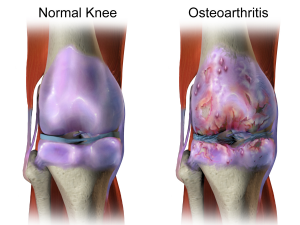
Vitamin D research.
Research has shown that those whose blood vitamin D measurements were in the middle and lowest thirds of serum vitamin D levels, had a threefold progression of osteoarthritis of the knee during a one-to-two year period. That is, when compared to those in the highest third. Low blood levels of vitamin D also predicted greater loss of cartilage in the joints.[1]
Other research demonstrates that in patients with arthritis of the knee, those with blood levels of vitamin D lower than 20 ng/ml (very low) have more disability. They also have more pain and more weakness than those with higher levels.[2], [3] Low vitamin D levels also correlate closely to greater knee pain and walking difficulty.[4]
Remember, unless it is stated that 25(OH)D levels are a result of supplementation or dietary sources, those levels are dependent on sun exposure. The research on osteoarthritis, discussed above, therefore, is really research on sun exposure.
Another horrific effect of arthritis.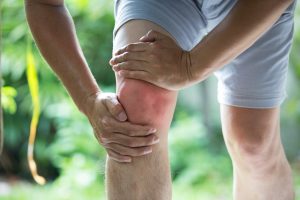
Arthritic joints carry another devastating side effect. Hip replacement surgery is often prescribed for arthritic conditions: those people who go through total-hip-replacement procedures are 4.7 times as likely to have an ischemic stroke. They are also 4.4 times as likely to have a hemorrhagic stroke in the first two weeks post surgery.[5] Those stroke risks remain elevated for 6-12 weeks. The term “ischemic” means producing a local deficiency of blood supply by obstructing blood flow.
Sun exposure, therefore, has a protective effect against arthritis. Consequently, it has the potential to prevent hip-replacement surgery. In addition, it has the potential to prevent strokes.
Consider an article from the Express,[6] a UK online newspaper. It describes research published in the scientific journal, Annals of the Rheumatic Diseases,[7]stating the following: “Millions of people could protect themselves from crippling arthritis by getting a regular dose of sunshine. Scientists found that women with the highest levels of exposure to the sun – specifically Ultraviolet B (UVB) light – were 21 per cent less likely to develop the disease.”
Safely embrace the sun, help prevent osteoarthritis and safeguard your health.
[1] McAlindonTE, Felson DT, Zhang Y, Hannan MT, Aliabadi P, Weissman B, Rush D, Wilson PW, Jacques P. Relation of dietary intake and serum levels of vitamin D to progression of osteoarthritis of the knee among participants in the Framingham Study. Ann Intern Med 1996;125:353-9.
[2] Baker K, Zhang YQ, Goggins J. Hypovitaminosis D and its association with muscle strength, pain and physical function in knee osteoarthritis (OA): a 30-month longitudinal, observational study; American College of Rheumatology meeting; San Antonio, TX; Oct 16-21, 2004; abstract 17552. Also see http://www.medscape.com/viewarticle/538061
[3] Baker K, Zhang YQ, Goggins J. Hypovitaminosis D and its association with muscle strength, pain and physical function in knee osteoarthritis (OA): a 30-month longitudinal, observational study; American College of Rheumatology meeting; San Antonio, TX; Oct 16-21, 2004; abstract 17552. Also see http://www.medscape.com/viewarticle/538061
[4] Wang, J., Nuite, M., Wheeler, L.M., Badiani, P., Joas, J., Mcadams, E.L., Fletcher, J., Lavalley, M.P., Dawson-Hughes, B., Mcalindon, T.E. 2007. Low Vitamin D levels are associated with greater pain and slow walking speed in patients with knee osteoarthritis (KOA). In: American College of Rheumatology Scientific Meeting, 11/6/07-11/11/07, Boston, MA. 56(9supplement): S124. Accessed May 14, 2010 at http://www.ars.usda.gov/research/publications/publications.htm?SEQ_NO_115=211611
[5] Lalmohamed A, Vestergaard P, Cooper C, de Boer A, Leufkens HG, van StaaTP, de Vries F. Hip replacement surgery and stroke. Stroke 2012;43(12):3225-9.
[6] http://www.express.co.uk/life-style/health/375632/Sun-helps-stop-arthritis. (accessed November 27, 2015).
[7] Arkema EV, Hart JE, Bertrand KA, Laden F, Grodstein F, Rosner BA, Karlson EW, Costenbader KH. Exposure to ultraviolet-B and risk of developing rheumatoid arthritis among women in the Nurses’ Health Study. Ann Rheum Dis. 2013 Apr;72(4):506-11




